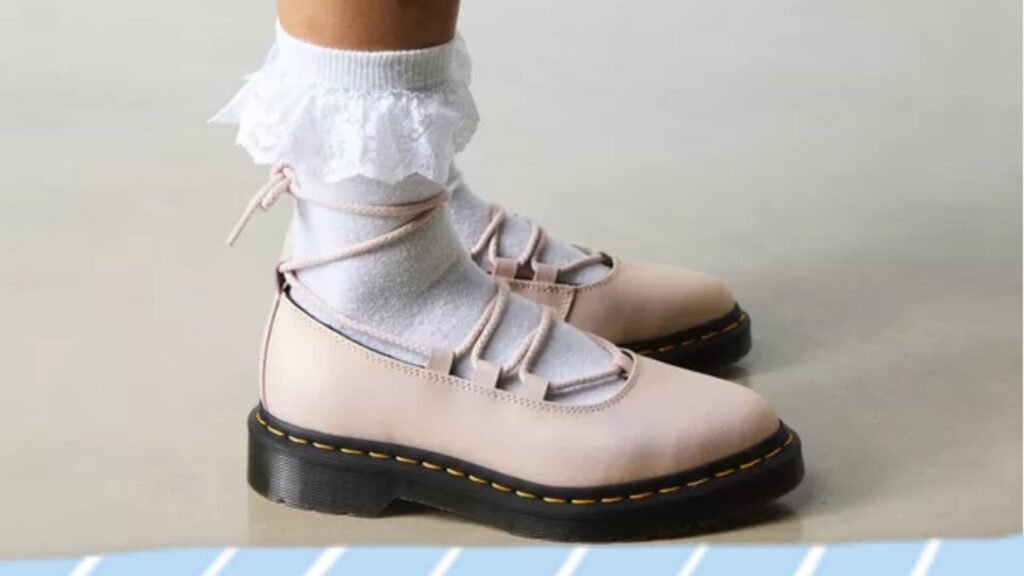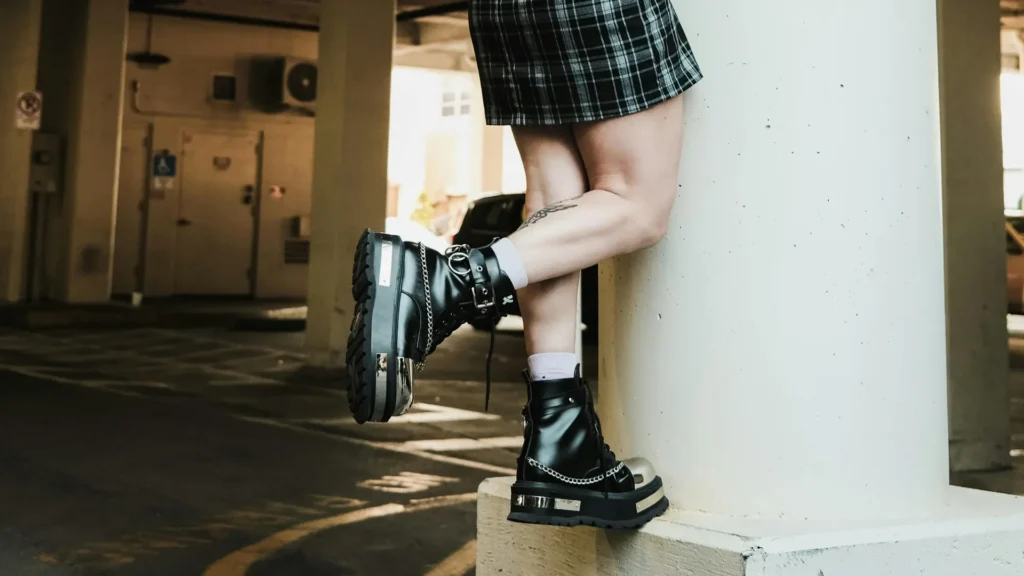In 1977, British punk rock burst forth, with bands such as the Sex Pistols drawing massive crowds in torn clothes and heavy boots. Dr. Martens, launched in 1947 as a humble work boot, became a punk icon. This shift redefined the brand forever.
Punk’s raw energy transformed Dr. Martens from practical footwear to a symbol of rebellion. Fans loved the bold look and durability, making the boots a staple of the movement. This article traces punk’s profound influence on Dr. Martens’ legacy.
The Origins of Dr. Martens and Their Journey into Punk Culture
In 1947, German doctor Dr. Klaus Maertens suffered a serious skiing injury that left him in pain and limited mobility. While recovering, he sought a comfortable alternative to traditional footwear and designed a soft, air-cushioned sole made from recycled rubber.
This innovative design provided both support and flexibility, offering relief during long walks. Seeing the potential for wider use, Maertens partnered with his friend Herbert Funck, an engineer, to refine the concept.
By the late 1950s, the boots caught the attention of the Griggs family, a British shoe manufacturer based in Northamptonshire. Recognizing the practical benefits of Maertens’ design, they acquired the rights to produce the boots in the United Kingdom.
On April 1, 1960, the first pair of British-made Dr. Martens rolled off the production line — the now-iconic 1460 boot, named after its launch date. It featured an eight-eyelet design, yellow stitching, black leather, and the signature air-cushioned sole.
Initially, the boots were marketed toward industrial workers, such as postmen, factory laborers, and delivery drivers, who needed durable, comfortable footwear. The tough leather and slip-resistant sole made them ideal for demanding jobs. However, despite their utility, the boots struggled to gain widespread popularity in their early years.
Punk’s Rise in Britain
Fast forward to the mid-1970s, when Britain was grappling with economic hardship. Unemployment soared to 5.4% in 1975, and inflation was rampant.
Many working-class youth felt disillusioned by the lack of opportunities and growing social inequality. In this climate of frustration and rebellion, punk rock emerged as a powerful cultural force.
Punk music, characterized by its raw energy and anti-establishment lyrics, resonated with disaffected youth. The Sex Pistols, The Clash, and Buzzcocks gave voice to the anger and alienation felt by many.
Alongside the music came a distinct fashion movement that rejected mainstream norms — embracing ripped clothing, DIY aesthetics, spiked hair, and bold accessories.
Dr. Martens Enters the Punk Scene
It was in this volatile cultural landscape that Dr. Martens found a new identity. The boots’ rugged durability, affordability, and distinctive look made them perfect for the punk lifestyle. Attendees at rowdy punk shows needed sturdy footwear for moshing and marching, and the 1460 model fit the bill.
Soon, the boots became a staple in the punk wardrobe. Worn unlaced, scuffed, or customized with paint, studs, and unique laces, each pair reflected the wearer’s individuality. The boots symbolized defiance against authority, aligning perfectly with punk ideology.
By 1979, Dr. Martens sales had increased by 70%, largely due to their adoption by the punk subculture. What had once been a niche product for workers had now become a symbol of rebellion and nonconformity.
Beyond mere fashion, Dr. Martens boots represented a stance against conformity and oppression. They were worn not just for style, but as a declaration of identity. Punks used the boots to assert their independence, reject societal expectations, and stand in solidarity with others who felt marginalized.
Over time, the brand embraced this association. Rather than distancing itself from the punk scene, Dr. Martens leaned into it, acknowledging its role in shaping youth culture and countercultural movements.
Today, Dr. Martens remain a global icon, transcending generations and subcultures. From skinheads to goths, grunge fans to modern-day punks, the boots continue to represent individuality, resilience, and resistance.
Though the company has expanded into a global fashion brand, collaborating with designers and celebrities, the DNA of the original 1460 boot remains unchanged — a testament to its enduring appeal and symbolic power.
Crafted from thick, tough leather and reinforced with a distinctive air-cushioned sole, the boots offered both protection and comfort. Punks could stomp, jump, and crowd surf all night without worrying about sore feet or worn-out shoes.
The soles absorbed impact, while the sturdy uppers resisted scuffs and tears, making them ideal for the rough-and-tumble world of punk gigs.
More than just functional, the boots became a symbol of endurance — much like the subculture itself. Worn by those who defied norms and embraced chaos, Dr. Martens proved they could withstand anything the scene threw at them.
The Sex Pistols’ Influence
No band embodied the raw energy and anti-establishment spirit of punk more than The Sex Pistols. Formed in 1975, the band quickly became the face of the UK punk explosion. Their incendiary performances and confrontational lyrics captured the frustration of a generation.
At their legendary 1977 shows — including the infamous boat gig on the Thames — photos captured fans wearing torn T-shirts, safety pins, and unmistakably rugged Dr. Martens boots. These images spread rapidly through music magazines, fanzines, and record sleeves, cementing the visual identity of punk.
The pairing of ripped jeans and scuffed-up Docs became iconic. It was a look that screamed rebellion and resistance, and it resonated far beyond the mosh pit. As the Sex Pistols rose to notoriety, so too did the boots they and their fans wore.
The association between Dr. Martens and punk exploded into mainstream consciousness, giving the brand a new lease on life.
While The Sex Pistols gave punk its shock value, The Clash brought political depth and global reach to the genre. Known for blending punk rock with reggae, ska, and rockabilly, the band also stood for working-class solidarity and social justice.
Their 1979 double album London Calling became a landmark release, selling over 2 million copies worldwide. At live shows promoting the album, fans could be seen in droves wearing Dr. Martens, reinforcing the boots’ place in punk’s visual language.
For many, the boots reflected The Clash’s ethos — tough, no-nonsense, and rooted in real-life struggles. Whether worn by factory workers or rebellious youth, Dr. Martens came to symbolize resilience and pride in one’s roots.
Through The Clash’s influence and international tours, the image of punk — and the boots that went with it — reached audiences across Europe, North America, and beyond. Dr. Martens gained street credibility as the footwear of choice for those who dared to speak truth to power.
Shifting Production and Perception: From Workboots to Cultural Icons
As punk’s popularity surged, so did the demand for Dr. Martens. Factories in Northamptonshire , the heart of British shoemaking, ramped up production to meet the growing appetite for the 1460 model.
By the early 1980s, the company was producing thousands of pairs daily, transforming what had once been a niche workboot into a youth culture phenomenon.
This shift wasn’t just economic — it was cultural. No longer associated solely with laborers and postmen, Dr. Martens had become a symbol of defiance, individuality, and counterculture cool.
Rather than resist this transformation, the company leaned into it. Marketing campaigns began to reflect the punk aesthetic, featuring bold imagery and edgy slogans. The brand embraced its role in shaping youth movements, setting the stage for decades of continued relevance in fashion, music, and subcultural identity.
While punk rock is often associated with male-fronted bands, women were central to shaping the movement, both as musicians and style icons. Among the most influential was Siouxsie and the Banshees, formed in 1976, which became a defining act of the UK punk and post-punk scenes.
Siouxsie Sioux, Poly Styrene of X-Ray Spex, and The Slits’ Ari Up didn’t just challenge musical norms — they redefined what it meant to be a woman in music, embracing raw vocal styles, political lyrics, and bold aesthetics.
In fashion, female punks used Dr. Martens boots to craft looks that defied traditional femininity. They paired them with ripped fishnets, short skirts, bondage pants, or leather jackets, creating an image that was both tough and unapologetically feminine.
This fusion broke fashion rules and celebrated individuality — and at the center of it all were the Docs.
By wearing Dr. Martens, women in punk added their own layer of strength and defiance to the brand’s identity. Their influence helped shift perceptions, showing that rebellion wasn’t gender-specific — and neither was the appeal of a good pair of boots.
Making Dr. Martens Uniquely Yours
One of punk’s core values was DIY (do-it-yourself) culture, where creativity came from personal expression rather than mass-produced trends. This mindset extended to clothing, accessories — and especially — Dr. Martens boots.
Punks transformed their Docs into personalized works of art:
- Painting: Boots were spray-painted or hand-painted with anarchist symbols, band logos, slogans, or abstract designs.
- Studs and spikes: Metal studs, safety pins, and chains were added for aggressive flair.
- Colored laces: Bright or mismatched laces became a signature look.
- Scuffing and wear: Deliberately scuffed or worn-in boots showed pride in lived experience and anti-commercialism.
Each pair told a story — whether political, artistic, or simply rebellious. For many, customizing their Docs was more than fashion; it was a form of self-expression and resistance.
This wave of customization only deepened the bond between punk and Dr. Martens. Rather than discourage modifications, the brand embraced the trend, reinforcing its connection to youth culture and creative freedom.
Economic Impact on the Brand
The adoption of Dr. Martens by the punk subculture had a profound economic impact on the company during the late 1970s and 1980s.
Sales surged as demand grew among young people eager to embrace the punk aesthetic. By the early 1980s, the brand began expanding its offerings beyond the original black 1460 model, introducing new colors like cherry red in 1980, catering to those who wanted more self-expression.
Revenue climbed steadily, and the brand saw increased interest not just from Britain but from international markets. The association with punk gave Dr. Martens a fresh identity — one rooted in youth, rebellion, and authenticity — helping it evolve from a niche workwear brand into a global fashion icon.
This growth allowed the company to invest in production, marketing, and product development, ensuring that Dr. Martens remained relevant across decades of cultural shifts.
As punk spread beyond the UK, so too did the popularity of Dr. Martens. By the early 1980s, the movement had taken root in cities across the United States, Germany, France, Japan, and beyond .
In New York City, The Ramones and other American punk pioneers wore Docs on stage and off, linking British punk roots with the emerging U.S. scene. In Los Angeles, hardcore punk bands adopted the same tough look. Across Europe, underground punk scenes flourished, each adopting Dr. Martens as part of their uniform.
By 1985, 25% of total Dr. Martens production was exported, according to internal records. The boots had become a transnational symbol of rebellion, worn by disaffected youth everywhere.
From Tokyo to Toronto, Berlin to Buenos Aires, Dr. Martens boots traveled the world alongside punk’s message of dissent, proving that some symbols of resistance truly are universal.
British punk, born in the 1970s, made Dr. Martens a rebel symbol. Boots shifted from workwear to a punk must-have. Sales and reach grew.
Punk’s legacy shapes the brand in 2025. Dr. Martens blends history and style. The impact lasts.




